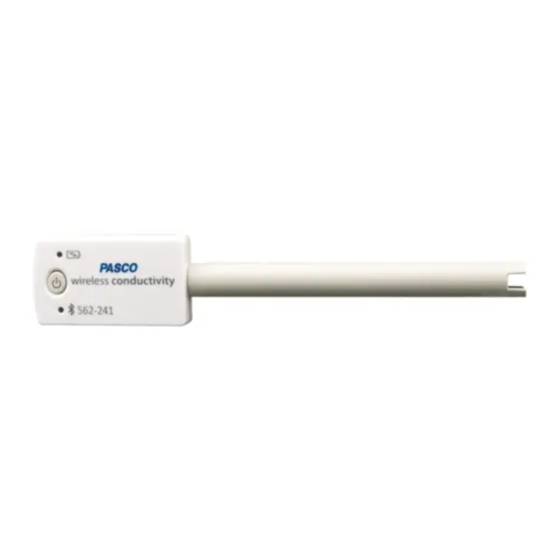
Table of Contents
Advertisement
Quick Links
Wireless Conductivity Sensor
Introduction
The Wireless Conductivity Sensor measures conductivity over a
range from 0 to 40,000 microsiemens/centimeter (µS/cm),
double the range of older versions. The probe is able to work in
a variety of solutions. Measurements are transmitted wirelessly
via Bluetooth and recorded and displayed by PASCO software
on a connected wireless device, such as a tablet or computer.
The Wireless Conductivity Sensor is powered by a replaceable
three volt coin cell battery (included) and is well-suited for
continuous recording and discrete measurements. The sensor is
designed to optimize the battery usage time.
Since each sensor has a unique device ID number, more than
one Wireless Conductivity Sensor can be connected to a
computer or tablet at the same time.
The sensor housing is water-resistant, but immersing it in liquid
may cause a loss of wireless connection. Only the Conductivity
Probe should be placed into the substance being measured.
Features
Battery Status LED
Indicates the battery level of the sensor by blinking red at
low power.
ON/OFF button
Press to turn the sensor on. Press and briefly hold to turn
the sensor off. Note that the sensor automatically turns
itself off after several minutes of inactivity if not connected.
Bluetooth Status LED
Indicates the status of the sensor's Bluetooth connection.
Bluetooth LED
Red blink
Green blink
Yellow blink
For information on remote data logging, see the PASCO
Capstone or SPARKvue online help.
Device ID number
Use this to identify the sensor when connecting via
Bluetooth.
Water-resistant gasket
Protects the sensor's internal components from water
damage in the event the sensor is exposed to water.
Sensor housing
Tolerates temperatures in the range of -15°C to +50°C.
Probe
Tolerates temperatures in the range of 0°C to 80°C.
Status
Ready to pair
Connected
Logging data
Background
Electrolytic conductivity is defined as the ability of a liquid to
conduct electrical current. In conductive solvents, dissolved ions
are the principle conductors of electricity. By selecting the
appropriate electrode, one can easily measure the electrical
conductivity of liquids ranging from ultra-pure water to extremely
salty solutions.
How well a solution conducts electricity is dependent on the
following parameters:
• Concentration of ions
• Mobility of ions
• Valence of ions
• Solution temperature
The Wireless Conductivity Sensor determines the electrical
conductivity (EC) of a solution by measuring the alternating
current (AC) flowing through a circuit when an AC signal is
applied to a 2-cell electrode submerged in the solution.
The accuracy of conductive measurements depends on the
following factors:
• Absence of contamination
• Resistance of the electrodes to polarization
• Consistent electrode geometry (cell constant) between
calibration and measurement
• Consistent temperature between calibration and
measurement
Other features
• Data from the Wireless Conductivity Sensor can be used to
determine Total Dissolved Solids (TSD).
• The sensor measures temperature and automatically
compensates for it.
Sensor theory
Conductance is the reciprocal of resistance. Conductivity is the
specific conductance of a material, or the conductance
measured between the opposite faces of a one centimeter cube
of a material.
The electrode cell in the end of the Conductivity Probe is
constructed of an insulating material embedded with stainless
steel pins. These metal contacts serve as sensing elements and
are placed at fixed distances apart.
Get the software
You can use the sensor with SPARKvue or PASCO Capstone
software. If you're not sure which to use, visit
pasco.com/products/guides/software-comparison.
SPARKvue is available as a free app for Chromebook, iOS, and
Android devices. We offer a free trial of SPARKvue and
Capstone for Windows and Mac. To get the software, go to
pasco.com/downloads
or search for SPARKvue in your device's
app store.
Product Guide | 012-14997C
(PS-3210A)
1
Advertisement
Table of Contents

Summary of Contents for PASCO PS-3210A
- Page 1 Capstone or SPARKvue online help. Get the software Device ID number Use this to identify the sensor when connecting via You can use the sensor with SPARKvue or PASCO Capstone Bluetooth. software. If you’re not sure which to use, visit Water-resistant gasket pasco.com/products/guides/software-comparison.
-
Page 2: Set Up The Software
Wireless Conductivity Sensor | PS-3210A If you have installed the software previously, check that you have PASCO Capstone the latest update: Connecting the sensor to a computer: SPARKvue 1. Turn on the Wireless Conductivity Sensor. Check to make sure the Bluetooth Status LED is blinking red. -
Page 3: Calibrating The Sensor
Therefore, like all the first standard solution into the Standard Value box, PASCO wireless products, the Wireless Conductivity Sensor is then click Set Calibration. designed for long battery life. For example, after several minutes of inactivity, the sensor turns itself off to preserve the battery. -
Page 4: Battery Removal And Replacement
Replacing the Battery Compartment Door Software help Put the Battery Compartment Door, The SPARKvue and PASCO Capstone Help provide additional along with the new battery, back onto information on how to use this product with the software. You the sensor. Align the indicator on the can access the help within the software or online. -
Page 5: Specifications And Accessories
Visit pasco.com/freelabs/PS-3210A. PASCO and PASCO scientific are trademarks or registered trademarks of PASCO scientific, in the United States and in other countries. All other brands, products, or service names are or may be trademarks or service marks of, and are used to Technical support identify, products or services of, their respective owners.















Need help?
Do you have a question about the PS-3210A and is the answer not in the manual?
Questions and answers